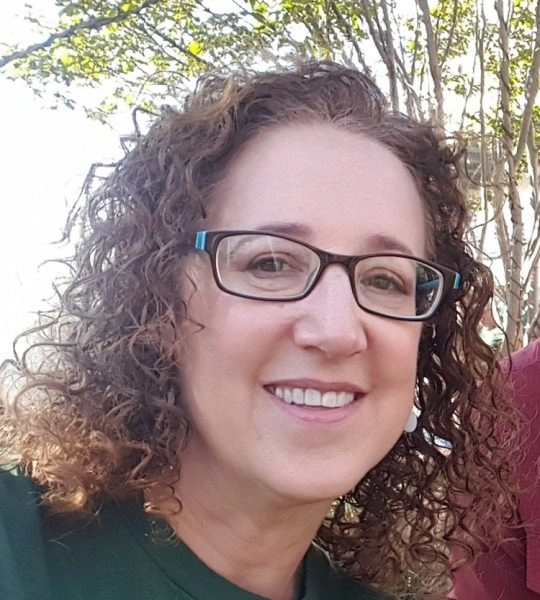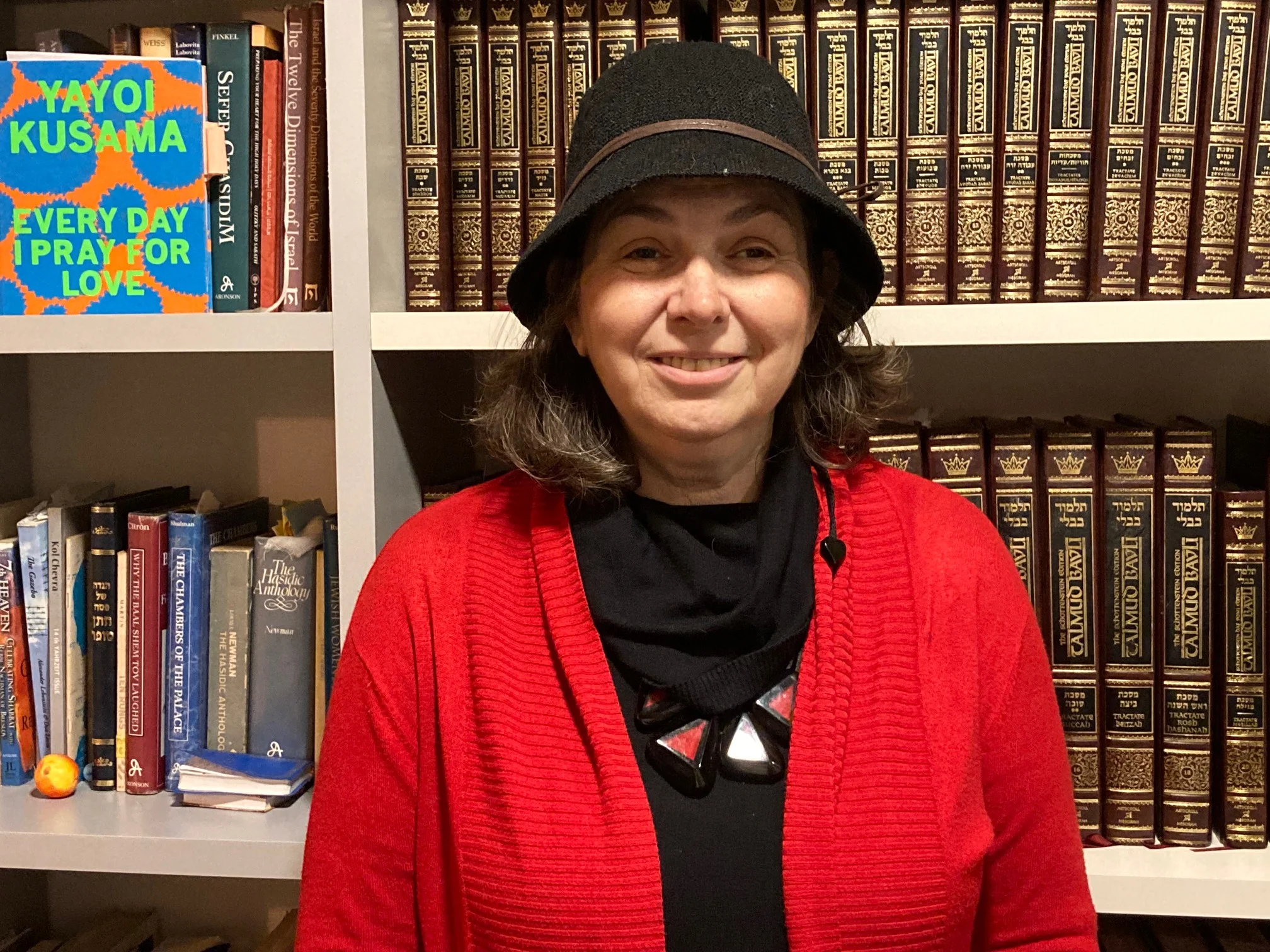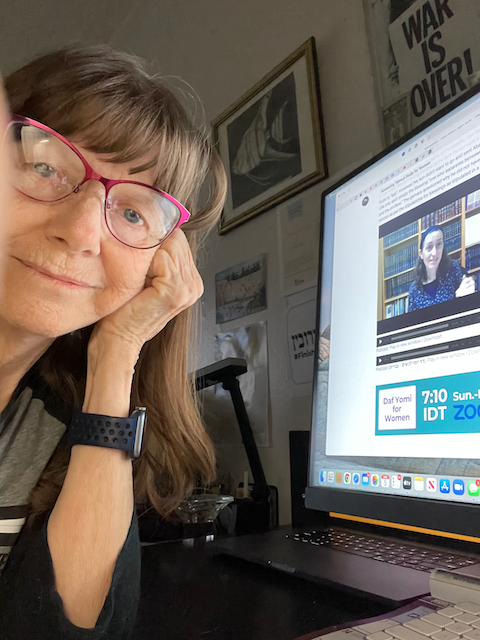Zevachim 42
Share this shiur:
Masechet Zevachim
Masechet Zevachim is sponsored by Esther Kremer in loving memory of her father, Manny Gross on his third yahrzeit. “He exemplified a path of holiness and purity, living with kedushah in his everyday life.”
This week’s learning is sponsored by Robert and Paula Cohen in loving memory of Joseph Cohen, Yosef ben Moshe HaCohen, z”l. “He was hard working, loved to sing, esp. as a chazan, and was very dedicated to his family and community.”
Want to dedicate learning? Get started here:


Summary
Reish Lakish interprets Rabbi Meir’s position in a Mishna in Menachot as holding that an offering becomes pigul not due to improper intent during part of the matir (the enabling act), but rather when improper intent occurs during the first stage, and the second stage is performed without any intent, the second stage is still governed by the initial improper thought.
Rabbi Shmuel bar Yitzchak disagrees, asserting that Rabbi Meir maintains one can render an offering pigul even through improper intent during part of an action.
Two difficulties are raised against Reish Lakish’s explanation based on two halakhot in the Tosefta. Regarding the first, three attempts are made to resolve the contradiction, but each faces its own challenge. One difficulty is also raised against Rabbi Shmuel bar Yitzchak’s position, but it is successfully resolved.
Today’s daily daf tools:
Masechet Zevachim
Masechet Zevachim is sponsored by Esther Kremer in loving memory of her father, Manny Gross on his third yahrzeit. “He exemplified a path of holiness and purity, living with kedushah in his everyday life.”
This week’s learning is sponsored by Robert and Paula Cohen in loving memory of Joseph Cohen, Yosef ben Moshe HaCohen, z”l. “He was hard working, loved to sing, esp. as a chazan, and was very dedicated to his family and community.”
This week’s learning is sponsored by Aunt Elayne, Fredjs, Hageges, Somers, Greenstones, and Pilichowskis in honor of Lana Kerzner’s birthday. “We admire so much how you continue the Greenstone family legacy of intellectual curiosity coupled with daily dedication to learning and Judaism.”
Today’s daily daf tools:
Delve Deeper
Broaden your understanding of the topics on this daf with classes and podcasts from top women Talmud scholars.
New to Talmud?
Check out our resources designed to help you navigate a page of Talmud – and study at the pace, level and style that fits you.
The Hadran Women’s Tapestry
Meet the diverse women learning Gemara at Hadran and hear their stories.
Zevachim 42
אֲבָל דָּמִים הַנִּיתָּנִין עַל הַמִּזְבֵּחַ הַפְּנִימִי – כְּגוֹן אַרְבָּעִים וְשָׁלֹשׁ שֶׁל יוֹם הַכִּיפּוּרִים, וְאַחַד עָשָׂר שֶׁל פַּר כֹּהֵן מָשִׁיחַ, וְאַחַד עָשָׂר שֶׁל פַּר הֶעְלֵם דָּבָר שֶׁל צִיבּוּר; פִּיגֵּל בֵּין בָּרִאשׁוֹנָה וּבֵין בַּשְּׁנִיָּה וּבֵין בַּשְּׁלִישִׁית – רַבִּי מֵאִיר אוֹמֵר: פִּיגּוּל, וְחַיָּיבִין עָלָיו כָּרֵת; וַחֲכָמִים אוֹמְרִים: אֵין בּוֹ כָּרֵת עַד שֶׁיְּפַגֵּל בְּכׇל הַמַּתִּיר.
But with regard to the blood placed inside, i.e., in the Holy of Holies, on the Curtain, and on the inner altar, e.g., the forty-three presentations of the blood of the bull and goat of Yom Kippur, and the eleven presentations of the blood of the bull for an unwitting sin of the anointed priest, and the eleven presentations of the blood of the bull for an unwitting communal sin, if in those cases the priest had an intention that can render the offering piggul, whether during the first set of presentations, whether during the second set, or whether during the third set, i.e., in any of the requisite sets of presentations, Rabbi Meir says: The offering is piggul and one is liable to receive karet for its consumption. And the Rabbis say: There is no liability for karet unless he had an intention that can render the offering piggul during the performance of the entire permitting factor.
קָתָנֵי מִיהָא פִּיגֵּל בֵּין בָּרִאשׁוֹנָה בֵּין בַּשְּׁנִיָּה בֵּין בַּשְּׁלִישִׁית – וּפְלִיג!
In any event, this baraita teaches: If the priest had an intention that can render the offering piggul, whether during the first set of presentations, whether during the second set, or whether during the third set, and yet Rabbi Meir disputes the ruling of the Rabbis and says that the offering is piggul. If the priest’s intent renders the offering piggul whether it was during the first, second, or third set of presentations, evidently Rabbi Meir’s ruling must be based on the consideration that one can render an offering piggul during half a permitting factor. According to Rabbi Shimon ben Lakish’s claim that Rabbi Meir’s reason is that anyone who performs an action performs it with his initial intent, the offering should be piggul only if the first set of presentations was performed with an improper intention while the rest were performed silently.
אָמַר רַב יִצְחָק בַּר אָבִין: הָכָא בְּמַאי עָסְקִינַן – כְּגוֹן שֶׁפִּיגֵּל בִּשְׁחִיטָה, דְּחַד מַתִּיר הוּא. אִי הָכִי, מַאי טַעְמָא דְּרַבָּנַן?
Rav Yitzḥak bar Avin says: What are we dealing with here? We are not dealing with a case of a priest who had improper intention in the presentations themselves, where the issue of half a permitting factor is relevent. Rather, we are dealing with a case where he had an improper intention that can render the offering piggul during the act of slaughter. In other words, after presenting the blood of the bull inside the Sanctuary, the rest of the blood spilled, and he had to slaughter another bull so that he could continue with the presentations, this time on the Curtain. The reason for Rabbi Meir’s ruling is that the act of slaughter is one permitting factor, and therefore the priest’s improper intent involved an entire service, not half a permitting factor. The Gemara asks: If so, what is the reason for the ruling of the Rabbis?
אָמַר רָבָא: מַאן חֲכָמִים – רַבִּי אֶלְיעָזָר הִיא. דִּתְנַן: הַקּוֹמֶץ, וְהַלְּבוֹנָה, וְהַקְּטוֹרֶת, וּמִנְחַת כֹּהֲנִים, וּמִנְחַת כֹּהֵן מָשִׁיחַ, וּמִנְחַת נְסָכִים; שֶׁהִקְרִיב מֵאַחַת מֵהֶן כְּזַיִת בַּחוּץ – חַיָּיב. וְרַבִּי אֶלְיעָזָר פּוֹטֵר, עַד שֶׁיַּקְרִיב אֶת כּוּלָּן.
Rava says: Who are these Rabbis? This is the opinion of Rabbi Eliezer, as we learned in a mishna (109b): With regard to the handful of a meal offering, and the frankincense, and the incense, and the meal offering of priests, and the meal offering of the anointed priest, and the meal offering brought with the libations that accompany animal offerings, in a case where one sacrificed even an olive-bulk from any one of these, which should be sacrificed on the altar, outside the Temple, he is liable, as the burning of an olive-bulk is considered a proper burning. And Rabbi Eliezer deems him exempt unless he sacrifices the whole of any one of these items outside the Temple. This indicates that according to Rabbi Eliezer even when one performs a proper action he is not liable unless he completes the service. The same should apply to the slaughter of different bulls for different sets of presentations; one should be liable only if he rendered each of them piggul.
וְהָאָמַר רָבָא: וּמוֹדֶה רַבִּי אֶלְיעָזָר בְּדָמִים; דִּתְנַן, רַבִּי אֶלְיעָזָר וְרַבִּי שִׁמְעוֹן אוֹמְרִים: מִמָּקוֹם שֶׁפָּסַק – מִשָּׁם הוּא מַתְחִיל!
The Gemara raises a difficulty: How can you explain Rabbi Eliezer’s opinion with regard to the presentation of the blood in this manner? But doesn’t Rava say: And Rabbi Eliezer concedes with regard to blood that even one who sacrifices part of the blood outside the Temple is liable? As we learned in a mishna (Yoma 60a) that Rabbi Eliezer and Rabbi Shimon say: If the blood of the bull or goat of Yom Kippur spilled, even if this occurred in the middle of one of the sets of sprinklings, and the High Priest slaughtered another animal, nevertheless, from the place that he interrupted that particular rite, when the blood spilled, there he resumes performance of that rite. In Rabbi Eliezer’s opinion, each individual sprinkling in each of these rites is an act in and of itself, and therefore the offering can be rendered piggul through any one of them. This is certainly not the opinion of the Rabbis who disagree with Rabbi Meir in the baraita.
אֶלָּא אָמַר רָבָא: כְּגוֹן שֶׁפִּיגֵּל בָּרִאשׁוֹנָה, וְשָׁתַק בַּשְּׁנִיָּה, וְחָזַר וּפִיגֵּל בַּשְּׁלִישִׁית.
Rather, Rava says: Rabbi Shimon ben Lakish would explain that the baraita does not mean that the priest had an improper intention either during the first set of sprinklings or the second or the third. Instead, this is referring to a case where the High Priest had an improper intention that can render the offering piggul during the first set of sprinklings, in the Holy of Holies, and was silent during the second set of sprinklings, on the Curtain, and again had an improper intention that can render the offering piggul during the third set of sprinklings, on the inner altar. There is a certain novelty in this case according to the opinion of Rabbi Meir, who maintains that anyone who performs an action performs it with his initial intent.
מַהוּ דְּתֵימָא: אִי סָלְקָא דַעְתָּךְ עַל דַּעַת רִאשׁוֹנָה הוּא מִיהְדָּר – פִּיגּוּלֵי בַּשְּׁלִישִׁית לְמָה לִי? קָא מַשְׁמַע לַן. מַתְקֵיף לַהּ רַב אָשֵׁי: מִידֵּי ״שָׁתַק״ קָתָנֵי?!
Rava elaborates: Lest you say that if it enters your mind that when the priest performs the second set of sprinklings he does so with his initial intent, i.e., that which he had at the time of the first set of sprinklings, why do I need him once again to have an improper intention that can render the offering piggul during the third set of sprinklings? Doesn’t his explicit intent during the third set of sprinklings indicate that he did not have this intent during the second set of sprinklings? Therefore, the baraita teaches us that this is not so, but rather his silence during the second set is considered a continuation of his initial intent. Rav Ashi objects to this: Is it taught that he was silent during the second set of sprinklings? According to Rava’s interpretation this is the key detail of the case, and yet it is not mentioned in the baraita.
אֶלָּא אָמַר רַב אָשֵׁי: הָכָא בְּמַאי עָסְקִינַן – כְּגוֹן שֶׁפִּיגֵּל בָּרִאשׁוֹנָה וּבַשְּׁנִיָּה וּבַשְּׁלִישִׁית; מַהוּ דְּתֵימָא: אִי סָלְקָא דַּעְתָּךְ כׇּל הָעוֹשֶׂה עַל דַּעַת רִאשׁוֹנָה הוּא עוֹשֶׂה – מִהְדָּר פִּיגּוּלֵי בְּכֹל חֲדָא וַחֲדָא לְמָה לִי? קָא מַשְׁמַע לַן.
Rather, Rav Ashi said: What are we dealing with here? We are dealing with a case where the High Priest had an intention that can render the offering piggul during the first set of sprinklings, in the Holy of Holies, and during the second set, on the Curtain, and during the third, on the corners of the inner altar. But during the fourth set, the sprinklings on the top of the inner altar, he was silent. Lest you say that if it enters your mind to say that anyone who performs an action performs it with his initial intent, why do I need him once again to have an improper intention that can render the offering piggul during each and every set of sprinklings? Therefore, the baraita teaches us that even so he is considered to have performed all the sprinklings with his initial intent.
וְהָא ״בֵּין בֵּין״ קָתָנֵי! קַשְׁיָא.
The Gemara raises a difficulty: How can Rav Ashi explain the baraita as referring to a case where the High Priest had an improper intention during the first, second, and third sets of sprinklings? But doesn’t the baraita teach: If the priest had an intention that can render the offering piggul, whether during the first set of presentations, whether during the second set, or whether during the third set? This indicates that he did not have improper intent during all the sprinklings but only in part of them. The Gemara comments: Indeed, this is difficult, as the wording of the baraita does not suit this interpretation.
אָמַר מָר, רַבִּי מֵאִיר אוֹמֵר: פִּיגּוּל, וְחַיָּיבִין עָלָיו כָּרֵת. מִכְּדֵי כָּרֵת לָא מִיחַיַּיב עַד שֶׁיִּקְרְבוּ כׇּל מַתִּירָיו – דְּאָמַר מָר: כְּהַרְצָאַת כָּשֵׁר כָּךְ הַרְצָאַת פָּסוּל; מָה הַרְצָאַת כָּשֵׁר – עַד שֶׁיִּקְרְבוּ כׇּל מַתִּירָיו, אַף הַרְצָאַת פָּסוּל – עַד שֶׁיִּקְרְבוּ כׇּל מַתִּירָיו.
§ The Gemara returns to discuss the baraita that addresses the blood presented inside the Sanctuary. The Master said that if the High Priest had an improper intention in one of the sets of presentations, e.g., inside the Holy of Holies, Rabbi Meir says: The offering is piggul and one is liable to receive karet for its consumption, despite the fact that he performed the rest of the rite silently. The Gemara asks: Now consider, one is not liable to receive karet unless all the permitting factors of the offering have been sacrificed, i.e., if the whole service is completed, including the presentation of the blood. As the Master said: As is the acceptance of a valid offering, so is the lack of acceptance of a disqualified offering: Just as there is no acceptance of a valid offering unless all its permitting factors have been sacrificed, so too, there is no lack of acceptance of a disqualified offering, i.e., it is not rendered piggul, unless all its permitting factors have been sacrificed. That is to say, in the absence of one of its permitting factors it does not become piggul.
וְהָא כֵּיוָן דְּחַשֵּׁיב בֵּיהּ בִּפְנִים פְּסוּלָה – כְּמַאן דְּלָא אַדֵּי דָּמֵי; כִּי הָדַר מַדֵּי בַּהֵיכָל – מַיָּא בְּעָלְמָא הוּא דְּקָא מַדֵּי!
But here, in the case of the bull or goat of Yom Kippur, since he intended to burn the offering beyond its designated time while he was sprinkling the blood inside the Holy of Holies, the sprinkling is not valid, and therefore the High Priest is considered like one who did not sprinkle the blood, as every one of the sprinklings of the blood of an inner sin offering is indispensable. If so, when he sprinkles the blood again later in the Sanctuary, on the Curtain and the inner altar, it is as though he is merely sprinkling water, and not the blood of the offering. Consequently, the permitting factors of the offering have not been sacrificed, and therefore the offering should not be rendered piggul.
אָמַר רַבָּה: מַשְׁכַּחַתְּ לַהּ בְּאַרְבָּעָה פָּרִים וּבְאַרְבָּעָה שְׂעִירִים.
Rabba says: You find it in a case of four bulls and of four goats. After sprinkling blood inside the Holy of Holies with the intent to burn the offering beyond its designated time, the blood spilled. Since the priest did not use that blood again, the service inside the Holy of Holies was completed, and that permitting factor was performed properly. He then had to slaughter another bull and goat for the other sprinklings inside the Sanctuary, which he again performed with improper intent and again the blood spilled. The same sequence repeated itself in the sprinklings on the inner altar and on the top of the altar. In this manner each permitting factor was performed properly.
רָבָא אָמַר: אֲפִילּוּ תֵּימָא בְּפַר אֶחָד וְשָׂעִיר אֶחָד, לְפִיגּוּלוֹ מְרַצֶּה.
Rava said: You may even say that this is a case where there is only one bull and one goat, as the sprinkling effects acceptance with regard to the offering’s status of piggul. In other words, even though the High Priest sprinkled the blood inside the Holy of Holies with an improper intention, and thereby disqualified the offering, nevertheless, since he completed the service, he is considered as having sacrificed all the permitting factors with regard to piggul.
אַרְבָּעִים וְשָׁלֹשׁ. וְהָא תַּנְיָא אַרְבָּעִים וְשֶׁבַע! הָא כְּמַאן דְּאָמַר מְעָרְבִין לַקְּרָנוֹת, וְהָא כְּמַאן דְּאָמַר אֵין מְעָרְבִין לַקְּרָנוֹת.
§ The baraita mentioned that there are forty-three presentations of the blood of the bull and the goat of Yom Kippur. The Gemara asks: But isn’t it taught otherwise in a different baraita, that there are forty-seven presentations of that blood? The Gemara answers: This statement, that there are forty-three presentations, is in accordance with the opinion of the one who says that the High Priest mixes the blood of the bull and the goat before placing it on the corners of the inner altar, rather than placing the blood of each one separately. And that statement, that there are forty-seven presentations, is in accordance with the opinion of the one who says that the High Priest does not mix the two types of blood before placing them on the corners, but sprinkles four times from the blood of the bull and another four times from the blood of the goat, and only afterward mixes the blood of the two animals for placement on the top of the altar.
וְהָא תַּנְיָא אַרְבָּעִים וּשְׁמוֹנֶה! הָא כְּמַאן דְּאָמַר שִׁירַיִים מְעַכְּבִין, הָא כְּמַאן דְּאָמַר אֵין שִׁירַיִים מְעַכְּבִין.
The Gemara raises another difficulty: But isn’t it taught in yet another baraita that there are forty-eight presentations? The Gemara answers: This statement, that there are forty-eight presentations, is in accordance with the opinion of the one who says that the pouring of the remainder of the blood on the base of the external altar is indispensable, and therefore this act is added to the total. That statement, that there are only forty-seven presentations, is in accordance with the opinion of the one who says that the pouring of the remainder of the blood is not indispensable.
מֵיתִיבִי: בַּמֶּה דְּבָרִים אֲמוּרִים – בִּקְמִיצָה, בְּמַתַּן כְּלִי וּבְהִילּוּךְ;
The Gemara raises an objection to Rabbi Shimon ben Lakish’s understanding of Rabbi Meir’s opinion, that one cannot render an offering piggul with an improper intention during the performance of half a permitting factor, from a baraita discussing piggul of a meal offering, which states: In what case is this statement said, i.e., that if the priest had an improper intention during the performance of one of its services, the offering is piggul, despite the fact that he performed the rest of the services silently? When he had the improper intention in the removal of the handful, or in the placement of the handful in a service vessel, or in the walking with the handful to the altar.
אֲבָל בָּא לוֹ לְהַקְטָרָה – נָתַן אֶת הַקּוֹמֶץ בְּמַחְשָׁבָה וְאֶת הַלְּבוֹנָה בִּשְׁתִיקָה, אוֹ שֶׁנָּתַן אֶת הַקּוֹמֶץ בִּשְׁתִיקָה וְאֶת הַלְּבוֹנָה בְּמַחְשָׁבָה – רַבִּי מֵאִיר אוֹמֵר: פִּיגּוּל, וְחַיָּיבִין עָלָיו כָּרֵת. וַחֲכָמִים אוֹמְרִים: אֵין בּוֹ כָּרֵת עַד שֶׁיְּפַגֵּל בְּכׇל הַמַּתִּיר.
But if he came to perform the burning of the handful and the frankincense, and he presented the handful on the altar with an improper intention and the frankincense he presented silently, or he presented the handful silently and the frankincense he presented with an improper intention, Rabbi Meir says: The offering is piggul and one is liable to receive karet for consuming it. And the Rabbis say: There is no liablility to receive karet unless the priest had an improper intention that can render the offering piggul during the performance of the entire permitting factor.
קָתָנֵי מִיהָא אֶת הַקּוֹמֶץ בִּשְׁתִיקָה וְאֶת הַלְּבוֹנָה בְּמַחְשָׁבָה – וּפְלִיג! אֵימָא: כְּבָר נָתַן אֶת הַלְּבוֹנָה בְּמַחְשָׁבָה.
In any event, this baraita teaches: Or he presented the handful silently and the frankincense he presented with an improper intention, and yet Rabbi Meir disagrees with the ruling of the Rabbis and says that the offering is piggul. This indicates that the decisive factor according to Rabbi Meir is not that the priest continues his initial intent, but that one can render an offering piggul during the performance of half a permitting factor. The Gemara answers: Say and explain the baraita as follows: Or he presented the handful silently after he had already presented the frankincense with an improper intention. In this case the offering is piggul because he performed the second action with his initial intent.
חֲדָא, דְּהַיְינוּ רֵישָׁא! וְעוֹד, הָא תַּנְיָא: וְאַחַר כָּךְ! קַשְׁיָא.
The Gemara refutes this interpretation: One counterclaim is that if this is what the baraita is saying, this is exactly the same case as the first clause. And furthermore, isn’t it taught explicitly in another baraita: And afterward he presented the frankincense with an improper intention. The Gemara states: Indeed, this is difficult for the opinion of Rabbi Shimon ben Lakish, who claims that according to Rabbi Meir one cannot render an offering piggul during the performance of half a permitting factor.
מַתְנִי׳ וְאֵלּוּ דְּבָרִים שֶׁאֵין חַיָּיבִין עֲלֵיהֶם מִשּׁוּם פִּיגּוּל – הַקּוֹמֶץ, וְהַקְּטֹרֶת, וְהַלְּבוֹנָה,
MISHNA: And these are the items for which one is not liable to receive karet due to violation of the prohibition of piggul. One is liable to receive karet only if he partakes of an item that was permitted for consumption or for the altar by another item. As for the items listed here, either nothing else renders them permitted for consumption or for the altar, or they themselves render other items permitted. They are as follows: The handful of flour, which permits consumption of the meal offering; the incense, which is burned in its entirety, without another item rendering it permitted for the altar; the frankincense, which is burned together with the handful of the meal offering;























